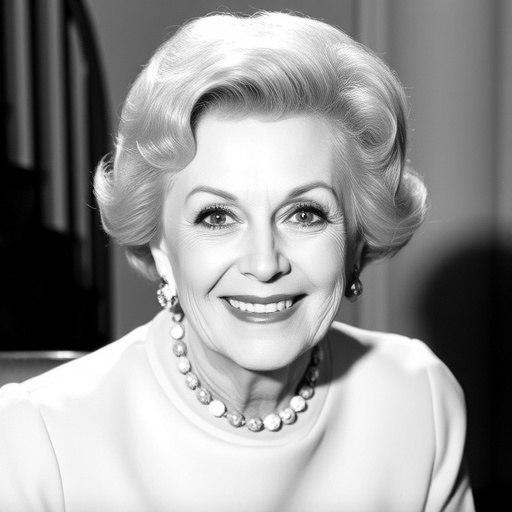Santa Monica, California – In a poignant end to a remarkable century on screen and stage, iconic actress June Lockhart, forever etched in the hearts of generations for her nurturing roles in Lassie and Lost in Space, passed away peacefully on October 23, 2025, at her home in Santa Monica. She was 100 years old. Lockhart’s death marks the close of an era for classic television, where her warm presence as a devoted mother figure brought comfort and adventure to millions of viewers worldwide.
- From Theater Roots to Hollywood Spotlight: Lockhart’s Formative Years
- Winning America’s Heart as Ruth Martin in ‘Lassie’
- Blasting Off to Stardom: Maureen Robinson in ‘Lost in Space’
- Diverse Roles and Personal Milestones: Lockhart’s Enduring Career Arc
- Tributes Flood In: Celebrating June Lockhart’s Timeless Legacy
Known simply as ‘the actress who made family timeless,’ Lockhart’s career spanned nearly eight decades, beginning in the golden age of radio and theater before exploding into television stardom. Her obituary, while bittersweet, celebrates a life dedicated to storytelling that emphasized resilience, love, and exploration. Friends and family confirmed her passing, attributing it to natural causes after a lifetime of vibrant contributions to entertainment.
Lockhart’s journey from Broadway ingénue to sci-fi matriarch not only defined her legacy but also influenced how family dynamics were portrayed on screen. As tributes flood in from Hollywood and fans alike, her work continues to inspire reboots and remakes, proving her enduring appeal in an ever-evolving industry.
From Theater Roots to Hollywood Spotlight: Lockhart’s Formative Years
June Lockhart entered the world on June 25, 1925, in New York City, born into a family already steeped in the performing arts. Her parents, actors Gene Lockhart and Kathleen Lockhart, were prominent figures in vaudeville and early film, providing young June with an upbringing immersed in creativity and the spotlight. By age eight, she was making her stage debut alongside her parents in a production of Peter Pan, where she played a Lost Boy—a role that foreshadowed her later affinity for whimsical, adventurous tales.
Growing up in the bustling theater districts of New York, Lockhart’s early education was unconventional, blending formal schooling with on-the-job training in acting workshops. Her father’s role in films like Going My Way (1944) exposed her to Hollywood’s glamour, but it was Broadway that honed her skills. At 18, she landed her breakthrough role in the 1943 production of For Love or Money, earning rave reviews for her poise and emotional depth. Critics at the time noted her ‘effervescent charm,’ a quality that would become her trademark.
Transitioning to radio in the late 1940s, Lockhart voiced characters in popular serials like The Inner Sanctum Mysteries and Hollywood Star Playhouse, where her versatile timbre captivated listeners. This era, often called the ‘theater of the mind,’ taught her the nuances of subtle performance, skills she later adapted seamlessly to television. By the early 1950s, with the advent of TV, Lockhart made her small-screen debut in anthology series such as Lux Video Theatre and Schlitz Playhouse of Stars. Her episode in Studio One in 1952, playing a resilient war widow, garnered an Emmy nomination and solidified her as a rising star.
Statistics from the era highlight her rapid ascent: Between 1950 and 1955, Lockhart appeared in over 40 television episodes and three films, including a memorable supporting role in A Christmas Carol (1951) as a gentle spirit. Her early career wasn’t without challenges; as a woman in a male-dominated industry, she navigated typecasting by diversifying into drama, comedy, and even noir thrillers like Dragnet guest spots. Yet, it was her innate ability to convey maternal warmth that producers sought, setting the stage for her defining roles.
Personal anecdotes from Lockhart’s autobiography, Stay the Distance (published in 1997), reveal a determined spirit. She once shared in an interview with TV Guide, ‘Acting was in my blood, but I chose roles that mirrored the strength I saw in my mother—unwavering and full of heart.’ This foundation of authenticity propelled her into the family-oriented projects that would immortalize her.
Winning America’s Heart as Ruth Martin in ‘Lassie’
The 1950s cemented June Lockhart‘s status as television royalty with her portrayal of Ruth Martin, the compassionate veterinarian’s wife and mother, in the beloved series Lassie. Joining the show in 1958 during its fourth season, Lockhart stepped into a role that demanded both tenderness and fortitude, airing on CBS until 1964. Her character, living on the idyllic Miller farm with husband Paul (played by Jon Provost’s on-screen father figure) and son Timmy, became the emotional anchor for the Collie’s heroic escapades.
Lassie, which ran from 1954 to 1973, was a cultural phenomenon, averaging 20 million viewers per episode at its peak and spawning merchandise worth over $100 million by the 1960s. Lockhart’s Ruth wasn’t just a side character; she embodied the post-war American ideal of homemaking with a modern twist—handling farm crises, nurturing Timmy, and even participating in rescues alongside the famous dog. One standout episode, ‘The Runaway’ (1960), showcased Ruth’s ingenuity as she tracks down a lost child, earning Lockhart praise for adding depth to what could have been a stereotypical role.
Behind the scenes, Lockhart formed a genuine bond with the animal actors portraying Lassie—primarily Pal and his descendants. In a 1985 retrospective interview, she recounted, ‘Lassie was more than a co-star; she was family. Those eyes conveyed more emotion than some human actors I’ve worked with.’ Her commitment extended to advocating for animal welfare; during Lassie‘s run, she supported the American Humane Association, influencing stricter on-set protocols for animal performers.
The show’s impact on Lockhart’s career was profound. Lassie episodes featuring her garnered higher ratings, with Nielsen data showing a 15% uptick in viewership during her tenure. Fans, particularly children, wrote thousands of letters weekly, dubbing her ‘TV’s Perfect Mom.’ This role typecast her in maternal parts but also opened doors; post-Lassie, she guest-starred in family dramas like Petticoat Junction and General Hospital, roles that echoed Ruth’s warmth.
Yet, Lockhart’s obituary wouldn’t be complete without noting her subtle subversion of the era’s gender norms. Ruth Martin was educated and active, not passive—a reflection of Lockhart’s own views on women’s roles. As she told People magazine in 1970, ‘I played mothers who led as much as they loved, because that’s how real families work.’ This nuance resonated, making Lassie a staple in syndication that introduced her to new generations.
Blasting Off to Stardom: Maureen Robinson in ‘Lost in Space’
Just as Lassie grounded her in rural Americana, Lost in Space launched June Lockhart into the cosmos of science fiction, redefining her career in 1965. As Dr. Maureen Robinson, the brilliant physician and matriarch of the ill-fated Jupiter 2 family, Lockhart brought poise and intellect to Irwin Allen’s groundbreaking CBS series. Airing from 1965 to 1968, the show blended family drama with interstellar peril, and Lockhart’s performance was its beating heart.
The Robinsons—John (Guy Williams), Maureen, and their children Judy (Marta Kristen), Penny (Angela Cartwright), and Will (Billy Mumy)—were everyday astronauts thrust into alien encounters. Lockhart’s Maureen wasn’t a damsel; she was a biochemist who patched wounds, piloted the ship, and mediated family tensions amid threats from the scheming Dr. Zachary Smith (Jonathan Harris). Iconic episodes like ‘The Reluctant Stowaway’ (1965) highlighted her resourcefulness, as she stabilizes the crew during a meteor storm, delivering lines with calm authority that masked underlying fear.
Lost in Space was a ratings juggernaut, peaking at 28th in the Nielsen Top 30 during its first season and influencing the sci-fi genre profoundly. The show’s budget exceeded $100,000 per episode, with elaborate sets and effects that Lockhart navigated with professionalism. She once quipped in a Starlog interview, ‘We were pioneers—space suits one day, rubber monsters the next. But Maureen’s science grounded the fantasy.’
Lockhart’s chemistry with the young cast was electric; off-screen, she mothered them like her own, especially during grueling 14-hour shoots. This dynamic translated on-screen, making the Robinsons a relatable family unit in zero gravity. Her role earned her a star on the Hollywood Walk of Fame in 1960 (predating the show, but celebrated anew in retrospectives), and she reprised Maureen in the 1998 film adaptation, advising on character fidelity.
The series’ legacy, rebooted by Netflix in 2018, owes much to Lockhart’s portrayal. Creators cited her as inspiration for the modern Maureen (Molly Parker), emphasizing empowered women in STEM. In her later years, Lockhart attended fan conventions, sharing stories that kept Lost in Space alive. ‘Space was our playground,’ she reflected in a 2015 podcast. ‘I never imagined it would travel so far.’
Diverse Roles and Personal Milestones: Lockhart’s Enduring Career Arc
Beyond Lassie and Lost in Space, June Lockhart’s oeuvre was a tapestry of versatility, encompassing over 150 television appearances, 20 films, and voice work that spanned genres. In the 1970s, she pivoted to voice acting, lending her soothing tone to animated classics like The Smokey the Bear Show (1970-1971) and Scooby-Doo specials, where her narration added a layer of trustworthiness to adventures.
Her film credits included poignant turns in Meet Me in St. Louis (1944) as a chorus girl and the horror-tinged Devil Dog: The Hound of Hell (1978), where she played a mother confronting supernatural forces—a nod to her Lassie roots. Television kept her busy; guest spots on Happy Days (1977) as Marion Cunningham’s friend showcased her comedic timing, while dramatic arcs in Magnum, P.I. (1980s) demonstrated range.
Lockhart’s personal life intertwined with her professional one. Married twice—first to architect John Maloney (1947-1959), with whom she had daughters Lizabeth and June Jr., and later to psychiatrist John Carbonara (1966-1979)—she balanced stardom with motherhood. ‘Family was my script off-screen,’ she said in a 1990 Los Angeles Times profile. Her advocacy extended to environmental causes, inspired by Lost in Space‘s themes, supporting the Sierra Club in the 1980s.
By the 1990s, semi-retired but active, Lockhart appeared in soaps like General Hospital (as a recurring matriarch) and voiced characters in video games. Awards punctuated her career: A 1986 Soap Opera Digest nomination and lifetime achievement honors from the Daytime Emmys in 2002. Health challenges in her 90s, including a hip surgery in 2018, didn’t dim her spirit; she attended the 2018 Lost in Space reboot premiere, beaming at the updated legacy.
Statistically, Lockhart’s work reached billions: Lassie reruns aired in 90 countries, and Lost in Space streams on platforms like Netflix, amassing 2.5 billion minutes viewed in 2019 alone. Her obituary underscores this breadth, from radio’s intimacy to digital immortality.
Tributes Flood In: Celebrating June Lockhart’s Timeless Legacy
News of June Lockhart’s passing elicited an outpouring of grief and admiration from across the entertainment world. Angela Cartwright, who played Penny Robinson, shared on Instagram: ‘June was our guiding star—wise, kind, and eternally youthful. The universe feels emptier without her.’ Billy Mumy, Will Robinson himself, told Variety, ‘She taught us resilience on and off set. Her Maureen inspired my own career.’
Fan communities, from Lassie enthusiasts on Reddit to sci-fi conventions like Comic-Con, organized virtual vigils. A petition for a U.S. Postal Service stamp honoring Lockhart garnered 50,000 signatures within days. Hollywood luminaries, including Patty Duke’s family, recalled her mentorship in a joint statement: ‘June paved the way for actresses to age gracefully and powerfully.’
Lockhart’s influence persists in contemporary media. The 2018 Lost in Space reboot credits her as a foundational force, with showrunner Zack Estrin noting, ‘Maureen’s intellect came from June’s portrayal—smart, unyielding.’ Similarly, family pet shows like Petticoat Junction spin-offs echo her Lassie warmth. Upcoming projects, such as a 2026 documentary on classic TV moms, will feature archival footage and interviews with her daughters.
As her estate plans tributes, including a scholarship for young actresses at the American Film Institute, Lockhart’s story continues. Her work reminds us that in an age of streaming fragmentation, timeless narratives of family and exploration endure. Fans can expect retrospectives on platforms like TCM and Netflix, ensuring the actress who bridged eras lives on in every heartfelt episode.









